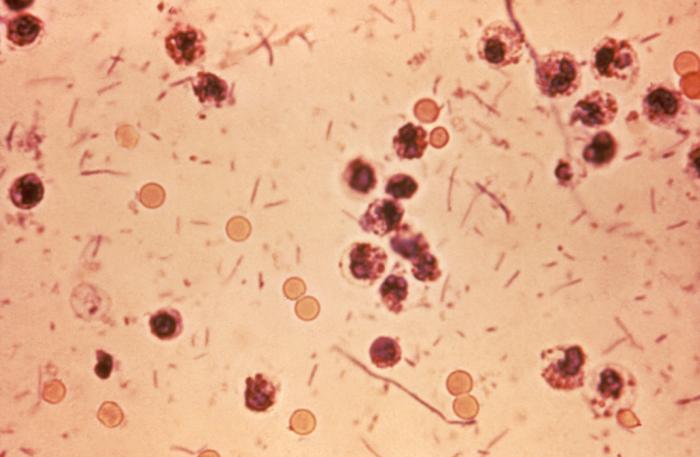Shigella: Difference between revisions
m (Robot: Automated text replacement (-{{SIB}} +, -{{EH}} +, -{{EJ}} +, -{{Editor Help}} +, -{{Editor Join}} +)) |
YazanDaaboul (talk | contribs) |
||
| Line 25: | Line 25: | ||
'''''Shigella''''' is a [[genus]] of [[Gram-negative]], [[Motility|non-motile]], [[Endospore|non-spore forming]] rod-shaped [[bacterium|bacteria]] closely related to ''[[Escherichia coli]]'' and ''[[Salmonella]]''. The causative agent of human [[shigellosis]], ''Shigella'' also cause disease in other [[primate]]s, but not in other mammals.<ref>{{cite book | author = Ryan KJ, Ray CG (editors) | title = Sherris Medical Microbiology | edition = 4th ed. | publisher = McGraw Hill | year = 2004 |isbn = 0-8385-8529-9 }}</ref> | '''''Shigella''''' is a [[genus]] of [[Gram-negative]], [[Motility|non-motile]], [[Endospore|non-spore forming]] rod-shaped [[bacterium|bacteria]] closely related to ''[[Escherichia coli]]'' and ''[[Salmonella]]''. The causative agent of human [[shigellosis]], ''Shigella'' also cause disease in other [[primate]]s, but not in other mammals.<ref>{{cite book | author = Ryan KJ, Ray CG (editors) | title = Sherris Medical Microbiology | edition = 4th ed. | publisher = McGraw Hill | year = 2004 |isbn = 0-8385-8529-9 }}</ref> | ||
== Pathogenesis == | == Pathogenesis == | ||
Revision as of 21:18, 5 April 2015
| Shigella | ||||||||||||
|---|---|---|---|---|---|---|---|---|---|---|---|---|
 Photomicrograph of Shigella sp. in a stool specimen
| ||||||||||||
| Scientific classification | ||||||||||||
| ||||||||||||
| Species | ||||||||||||
|
WikiDoc Resources for Shigella |
|
Articles |
|---|
|
Most recent articles on Shigella |
|
Media |
|
Evidence Based Medicine |
|
Clinical Trials |
|
Ongoing Trials on Shigella at Clinical Trials.gov Clinical Trials on Shigella at Google
|
|
Guidelines / Policies / Govt |
|
US National Guidelines Clearinghouse on Shigella
|
|
Books |
|
News |
|
Commentary |
|
Definitions |
|
Patient Resources / Community |
|
Directions to Hospitals Treating Shigella Risk calculators and risk factors for Shigella
|
|
Healthcare Provider Resources |
|
Causes & Risk Factors for Shigella |
|
Continuing Medical Education (CME) |
|
International |
|
|
|
Business |
|
Experimental / Informatics |
- This article is about the bacteria. For the disease, see shigellosis
Shigella is a genus of Gram-negative, non-motile, non-spore forming rod-shaped bacteria closely related to Escherichia coli and Salmonella. The causative agent of human shigellosis, Shigella also cause disease in other primates, but not in other mammals.[1]
Pathogenesis
Shigella infection is typically via ingestion (fecal–oral contamination); depending on age and condition of the host as few as ten bacterial cells can be enough to cause an infection. Shigella cause dysentery that results in the destruction of the epithelial cells of the intestinal mucosa in the cecum and rectum. Some strains produce enterotoxin and Shiga toxin, similar to the verotoxin of E. coli O157:H7.[2] Both Shiga toxin and verotoxin are associated with causing hemolytic uremic syndrome.
Shigella invade the host through epithelial cells of the small intestine. Using a Type III secretion system acting as a biological syringe, the bacterium injects Ipa protein into cell, triggering bacterial invasion, and the subsequently lysis of vacuolar membranes. It utilizes a mechanism for its motility by which its IcsA triggers actin polymerization in the host cell in a "rocket" propulsion fashion for cell-to-cell spread.
The most common symptoms are diarrhea, fever, nausea, vomiting, stomach cramps, and straining to have a bowel movement. The stool may contain blood, mucus, or pus (e.g. dysentery). In rare cases, young children may have seizures. Symptoms can take as long as a week to show up, but most often begin two to four days after ingestion. Symptoms usually last for several days, but can last for weeks. Shigella is implicated as one of the pathogenic causes of reactive arthritis worldwide.[3]
Severe dysentery can be treated with ampicillin, TMP-SMX, or fluoroquinolones such as ciprofloxacin.
External Links
- Genome information is available at the NIAID Enteropathogen Resource Integration Center (ERIC)
References
- ↑ Ryan KJ, Ray CG (editors) (2004). Sherris Medical Microbiology (4th ed. ed.). McGraw Hill. ISBN 0-8385-8529-9.
- ↑ Hale TL, Keusch GT (1996). Shigella. in: Baron's Medical Microbiology (Baron S et al, eds.) (4th ed. ed.). Univ of Texas Medical Branch. ISBN 0-9631172-1-1.
- ↑ Hill Gaston JS, Lillicrap MS (2003). "Arthritis associated with enteric infection". Best practice & research. Clinical rheumatology. 17 (2): 219–39. PMID 12787523.
ca:Shigel·la da:Shigella de:Shigella fa:شیگلا ko:이질균 it:Shigella he:Shigella nl:Shigella no:Shigella sv:Shigella uk:Shigella